ABS AUDI S4 2014 Owners Manual
[x] Cancel search | Manufacturer: AUDI, Model Year: 2014, Model line: S4, Model: AUDI S4 2014Pages: 296, PDF Size: 73.56 MB
Page 16 of 296
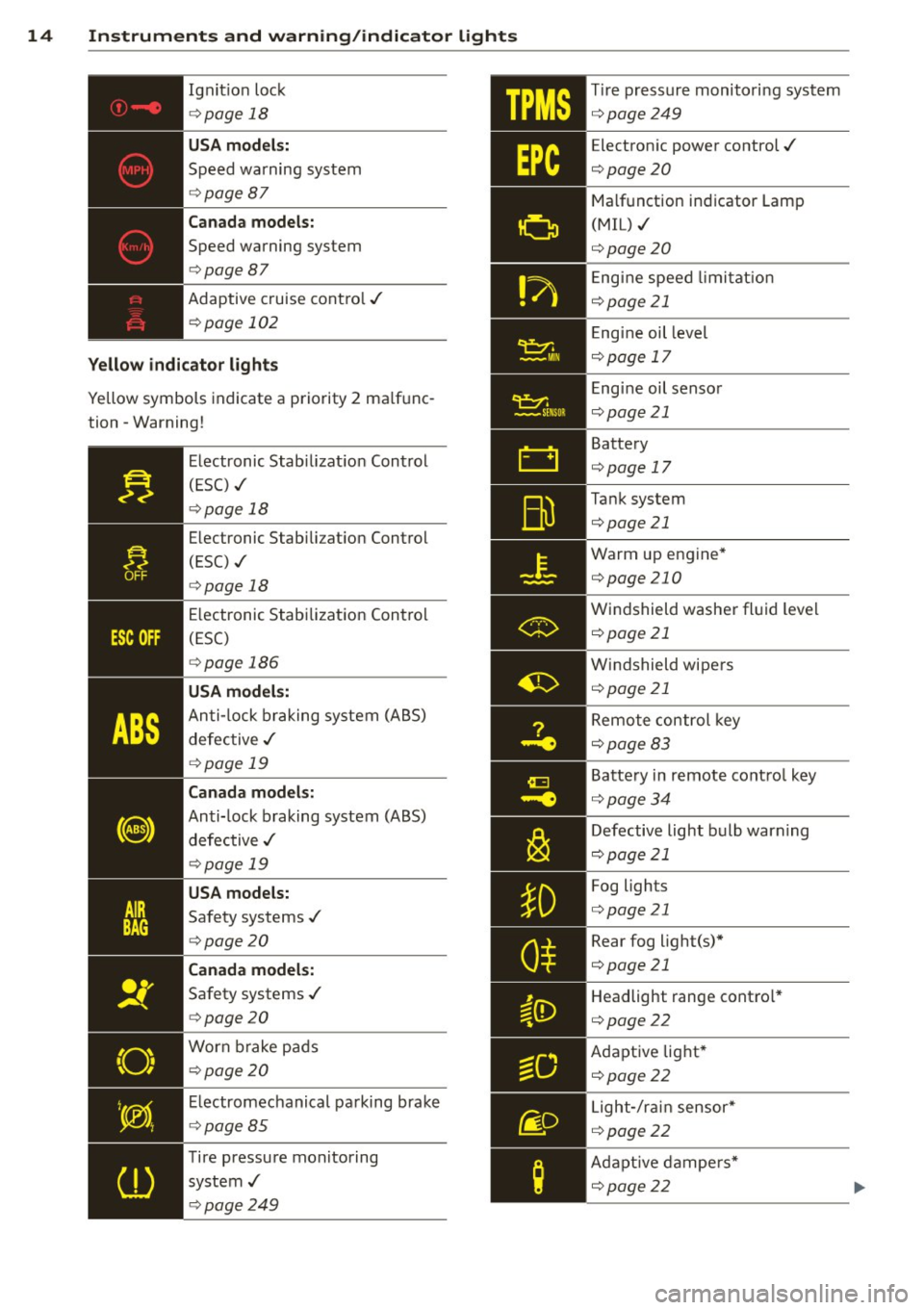
14 Instruments and warning/indicator lights
Ignit ion loc k
¢ page 18
USA models:
Speed warning sys tem
¢ page87
Canada models:
Speed warning system
¢page 87
Adaptive cruise cont ro l./
¢ page 102
Yellow indicator lights
Yellow symbols indicate a priority 2 ma lf u nc
tion -Warning!
Electronic Stab ilization Con trol
( E SC) ./
¢page 18
E lectronic Stab ili zat ion Contro l
(ESC) ./
¢ page 18
E lectronic Stab ilization Con trol
(ESC)
¢ page 186
USA models:
Anti- lock braking sy stem (A BS)
d efec tive ./
¢ page 19
Canada models:
Anti-lock b raking system (ABS)
defe ctive ./
¢page 19
USA models:
Safety systems ./
¢ pag e20
Canada models:
Safety systems ./
¢ page2 0
W orn brake pa ds
¢page 20
E lectromech anical pa rking bra ke
¢ page 85
T ire pressure mon itoring
system./
¢ page 24 9 T
ir e pressur e monitori ng sys tem
¢ page 249
E lectron ic powe r control ./
¢page20
Ma lf u nction ind icator Lamp
(MIL) ./
¢page20
E ng ine speed limi tat ion
¢page 21
E ng ine oil level
¢ page 17
E ng ine oil senso r
¢ pag e 21
Batte ry
¢ page 17
Ta nk system
¢page21
Warm up eng ine*
¢page 210
Windshield washe r fl uid leve l
¢ page 21
Win dshield wipers
¢ page 21
Remote control key
¢page8 3
B atte ry in remote co ntro l key
¢ page3 4
Defective light b ulb warn ing
¢ pag e 21
Fog lights
¢page21
Rear fog light(s)*
¢page21
Headlight range cont ro l*
¢page22
Adapt ive lig ht*
¢poge22
L ight -/r ain sensor *
¢ page22
A da ptive dampe rs*
¢page22
Page 17 of 296
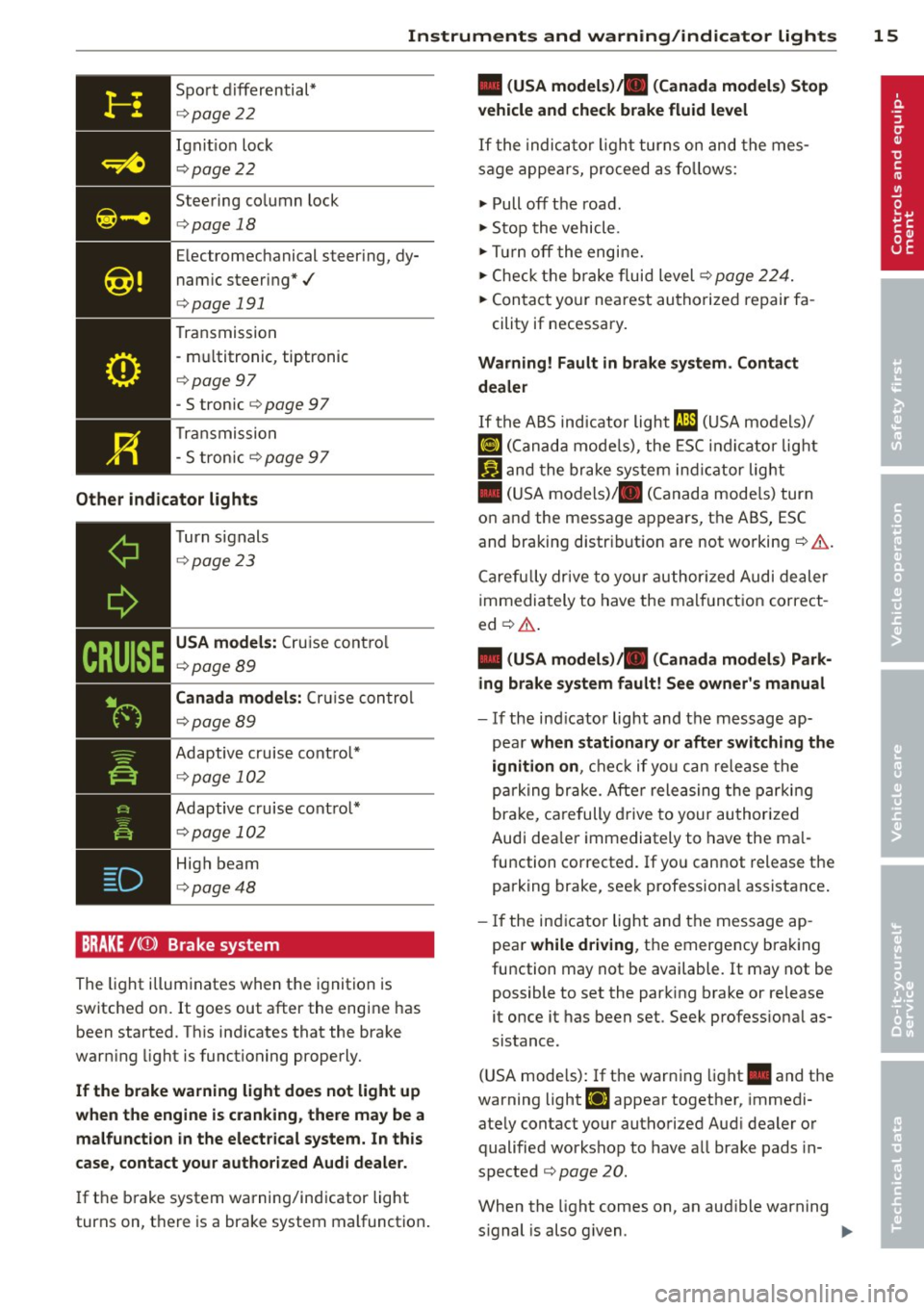
Instruments and warning/indicator lights 15
Sport d iffer ential*
¢ page 22
Ign it io n loc k
¢pag e 22
Steering co lumn lock
¢ pag e 18
Electromec hanical steer ing, dy
nam ic steer ing* ./
¢pag e 191
Transmission
- m ultitronic, tiptronic
¢ page 97
- S tronic
¢ page 97
T ran smi ssio n
- S tron ic
¢p age 9 7
Other indicator lights
CRUISE
Turn s ignals
¢ page 23
USA models: Cr uise con trol
¢page 89
Canada models: Crui se con tro l
¢p age89
Adaptive cruise cont ro l*
¢ page 102
Adaptive c ruise cont rol *
¢ page 1 02
High beam
¢ pag e48
BRAKE /((J)) Brake system
The light illum inates when the ignition is
switche d on .
It goes out after the engi ne has
been started. Th is in dicates that the bra ke
warn ing light is functioning properly.
If the brake warning light does not light up
when the engine is cranking , there may be a
malfunction in the electrical system. In this
case, contact your authorized Audi dealer.
I f t he b rake sy stem warning/ind icator light
turns on, t here is a bra ke system malfunction .
• (USA models)/ . (Canada models) Stop
vehicle and check brake fluid level
If t he indic ator lig ht tu rns on and the m es
s a ge a ppe ars, pro ceed as fo llows:
.,. Pull off t he roa d.
.,. Sto p t he vehicle .
.,. Turn off t he engi ne.
.,. Check t he bra ke fluid level ¢
page 224.
.,. Con tact yo ur nea rest au thorized re pair fa -
cility if necessary .
Warning! Fault in brake system. Contact
dealer
If the ABS ind icator light CD (USA mode ls)/
lG) < C anad a mo de ls), the ESC in dicato r light
If.) and the bra ke sys tem in dicat or lig ht
• (US A mo dels)/ . (Canada mode ls) turn
o n and the messa ge appears, the ABS, ESC
and brakin g distr ibution are not workin g¢ &. .
C arefu lly dr ive to your author ized Au di de aler
immedi ately to have the ma lf u nct ion correct
ed ¢&. .
• (USA models)/ . (Canada models) Park
ing brake system fault! See owner's manual
- If th e in di cator light and the m essag e ap -
pe ar
when stationary or after switching the
ignition on ,
check if yo u ca n re le a se the
p arki ng br ake. Afte r relea sing the park ing
bra ke, ca re fully drive to your au thori zed
A udi dea le r i mmediately to have the ma l
fu nct ion corrected . If yo u cannot release t he
parking brake, see k professiona l assistance .
- If the in dicator light and the message ap
pea r
while driving , th e e mergency bra king
fu nction may not be available. It may not be
possible to set the par king brake or re lease
it once it has been set. Seek profess io na l as
sistance.
( U SA mode ls) : If th e warn ing lig ht. and the
warning light
fi] appear togethe r, immedi
ate ly contact yo ur aut horized Aud i dealer o r
qualified wo rks hop t o have a ll brake pads in
s p ected
¢ page 20.
When the light comes on, an aud ible warning
s ignal is also g iven. .,.
Page 18 of 296
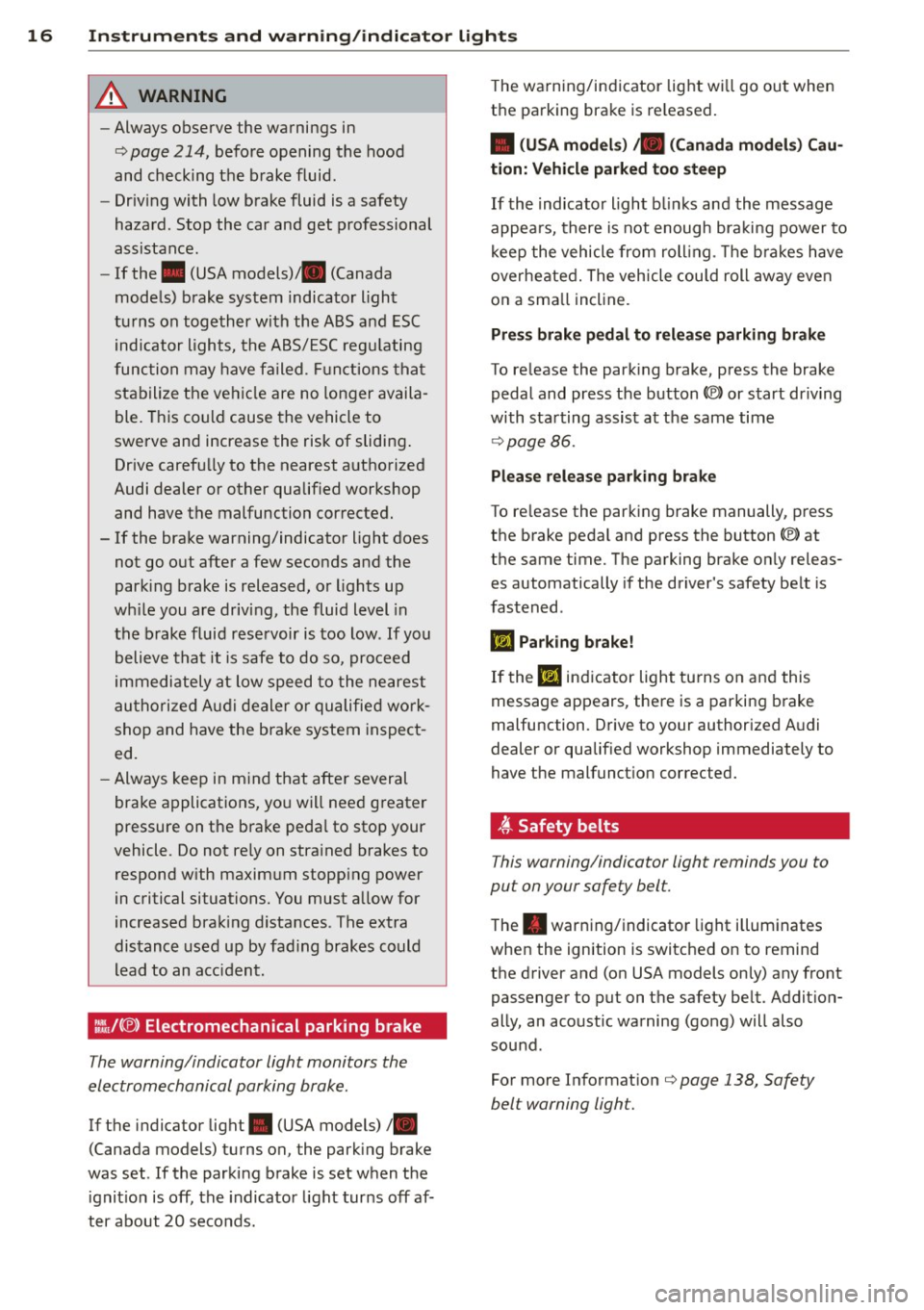
16 Instrum ent s and w arn ing /indic ato r light s
A WARNING
-Always observe the warnings in
i=> page 214, before opening the hood
and checking the brake fluid.
- Driv ing with low brake fluid is a safety
hazard. Stop the car and get professional
assistance.
- If the . (USA
models) ;II (Canada
models) brake system indicator l ight
turns on together with the ABS and ESC indicator lights, the ABS/ESC regu lating
function may have failed. F unctions that
stabilize the vehicle are no longer availa
ble. This could cause the vehicle to
swerve and increase the risk of sliding .
Drive carefu lly to the nearest authorized
Audi dealer or other qualified workshop
and have the malfunction corrected.
- If the brake warning/indicator light does not go out after a few seconds and the
park ing brake is released, or lights up
wh ile you are driving, the fluid level in
the brake fluid reservoir is too low . If you
believe tha t it is safe to do so, proceed
immediately at low speed to the nearest
authorized Audi dealer or qualified work shop and have the bra ke system inspect
ed.
- Always keep in m ind that after several
brake applications, yo u will need greater
pressure on the b rake peda l to stop your
vehicle. Do not re ly on strained brakes to
respond w ith maximum stopp ing power
in critical situations. You must allow for
increased brak ing distances . The extra
distance used up by fad ing brakes could
lead to an acc ident.
:fil.J(® ) Electromechanical parking brake
The warning/indicator light monitors the
electromechanical parking brake .
If the indicator light. (USA models)/ .
(Canada models) turns on, the park ing brake
was set . If the parking brake is set when the
ignit ion is off, the indicator light turns off af
ter about 20 seconds. T
he warn ing/indicator light wi ll go out when
the parking brake is re leased.
• (USA model s) /. (Canada mod els) Cau
ti on: Vehicle parke d too steep
If the indicato r light b links and the message
appea rs, there is not enough bra king power to
k eep the vehicle from roll ing . T he brakes have
overheated. The veh icle cou ld roll away even
on a sma ll incline.
Pre ss brak e pedal to rel eas e parking brake
To re lease the park ing brake, press the brake
pedal and press the button(®) or start driving
with sta rting assist at t he same time
i=> page 86.
Pl ease r elea se parking brake
To re lease the park ing brake manually, p ress
the brake pedal and press the button®) at
the same time. The parking brake on ly releas
es automatically if the driver's safety be lt is
fastened.
Iii Parking brake!
If t he Iii ind icator light tu rns o n and this
message appears, there is a parking brake
malfunction. Drive to your authorized A udi
dealer or qualified workshop immediately to
have the malfunct ion corrected.
~ Safety belts
This warning/indicator light reminds you to
put on your safety belt.
T he . warning/ indicator light illuminates
when the ignition is switched on to remind
the driver and (on USA models only) any front
passenger to put on the safety be lt. Addit ion
ally, an acoustic warning (gong) will also
sound.
For more Informat ion
c:> page 138, Safety
belt warning light.
Page 21 of 296
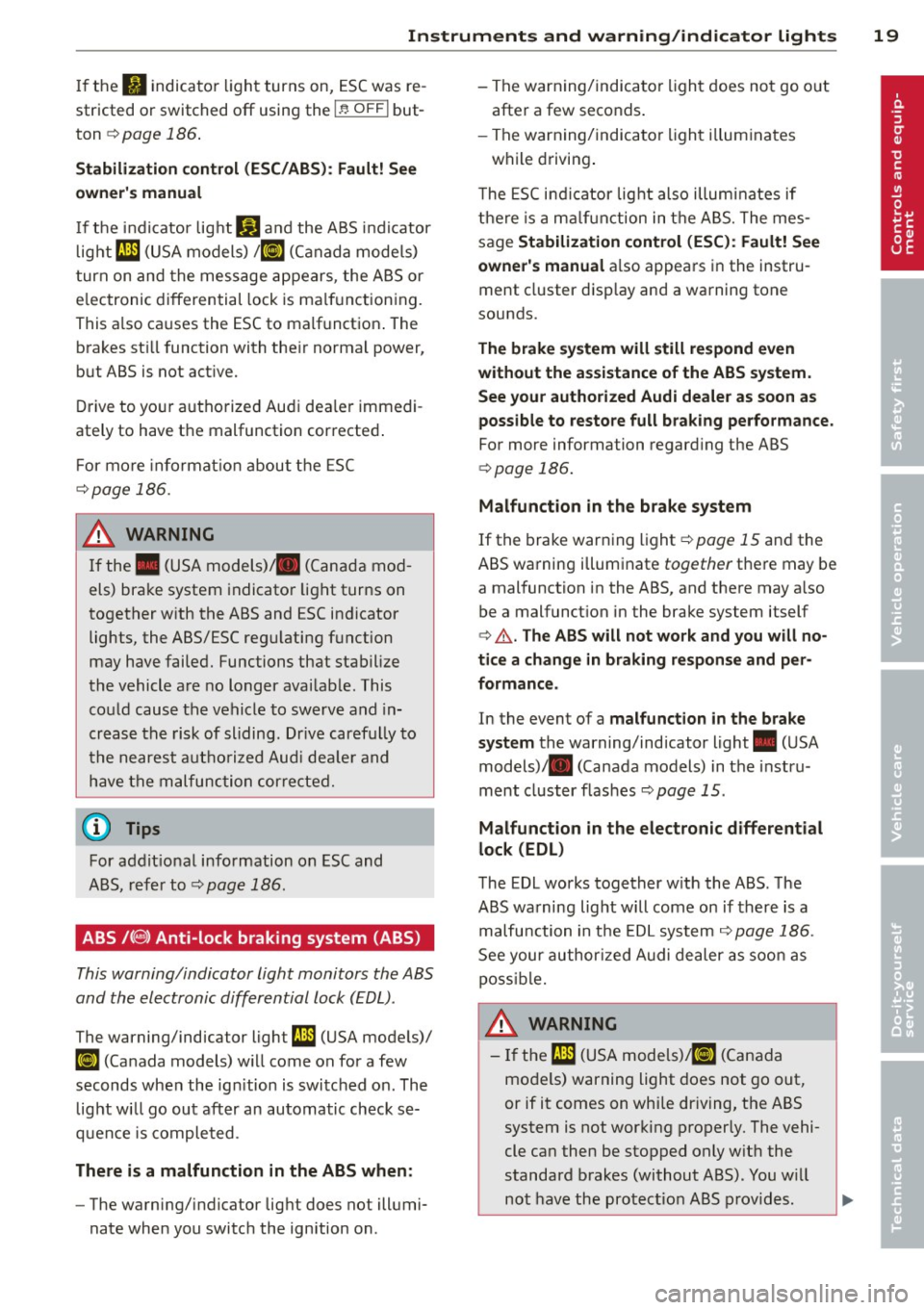
Instruments and warning/indicator lights 19
If the fl indicator light turns on, ESC was re
stricted or switched
off using the I ~ O FF I but
ton
¢ page 186.
Stabilization control (ESC/ABS): Fault! See
owner's manual
If the indicator light Ji) and the ABS indicator
light
ml (USA models) / II] (Canada models)
turn on and the message appears, the ABS or
e lectronic differential lock is ma lfunctioning.
This a lso ca uses the ESC to malfunction . The
brakes st ill function with their normal power,
but ABS is not act ive.
D rive to your authorized Audi dea ler immedi
ately to have the malfunction corrected .
Fo r more informat io n about the ESC
¢page 186.
A WARNING
If the . (USA models) . (Canada mod
els) brake system indicator light turns on
together with the ABS and ESC indicator
lights, the ABS/ESC regulating function
may have failed. Functions that stabilize
the vehicle are no longer avai lab le. This
could cause the vehicle to swerve and in
crease the risk of sliding. Drive carefu lly to
the nearest authorized Audi dea le r and
have the malfunction corrected.
(D Tips
For addit ional information on ESC and
ABS, refer to¢
page 186.
ABS /(8) Anti-lock braking system (ABS)
This warning/indicator light monitors the ABS
and the electronic differential lock (EDL).
The warning/indicator light ml (USA models)/
II] (Canada models) w ill come on for a few
seconds when the ign ition is switched on . The
light wi ll go out after an automatic check se
quence is completed.
There is a malfunction in the ABS when:
-The warning/ indicator light does not illumi
nate when you switch the ignition on . -
The warning/indicator light does not go out
after a few seconds.
- The warning/indicator light il luminates
while driving.
T he ESC indicator lig ht also illuminates if
there is a malfunction in the ABS. The mes
sage
Stabilization control (ESC): Fault! See
owner 's manual
also appears in the instru
ment cluster display and a warning tone
sounds.
The brake system will still respond even
without the assistance of the ABS system.
See your authorized Audi dealer as soon as
possible to restore full braking performance.
For more information regarding the ABS
¢page 186.
Malfunction in the brake system
If the brake warning light ¢page 15 and the
ABS warning illuminate
together there may be
a malfunction in the ABS, and there may a lso
be a malfunct ion in the brake system itself
¢ .&. .The ABS will not work and you will no
tice a change in braking response and per
formance.
In the event of a malfunction in the brake
system
the warning/indicator light . (USA
models) . (Canada models) in the instru
ment cluster flashes
¢ page 15 .
Malfunction in the electronic differential
lock (EDL)
The EDL works together with the ABS . The
ABS warning light will come on if there is a
malfu nction in the EDL system ¢
page 186.
See your authorized Audi dealer as soon as
poss ible.
A WARNING
-
-If the ml (USA models) tli] (Canada
models) warning light does not go out,
or if it comes on while dr iving, the ABS
system is not working properly. The vehi
cle can then be stopped only w ith the
standard brakes (without ABS). You w ill
not have the protect ion ABS provides.
...
Page 22 of 296
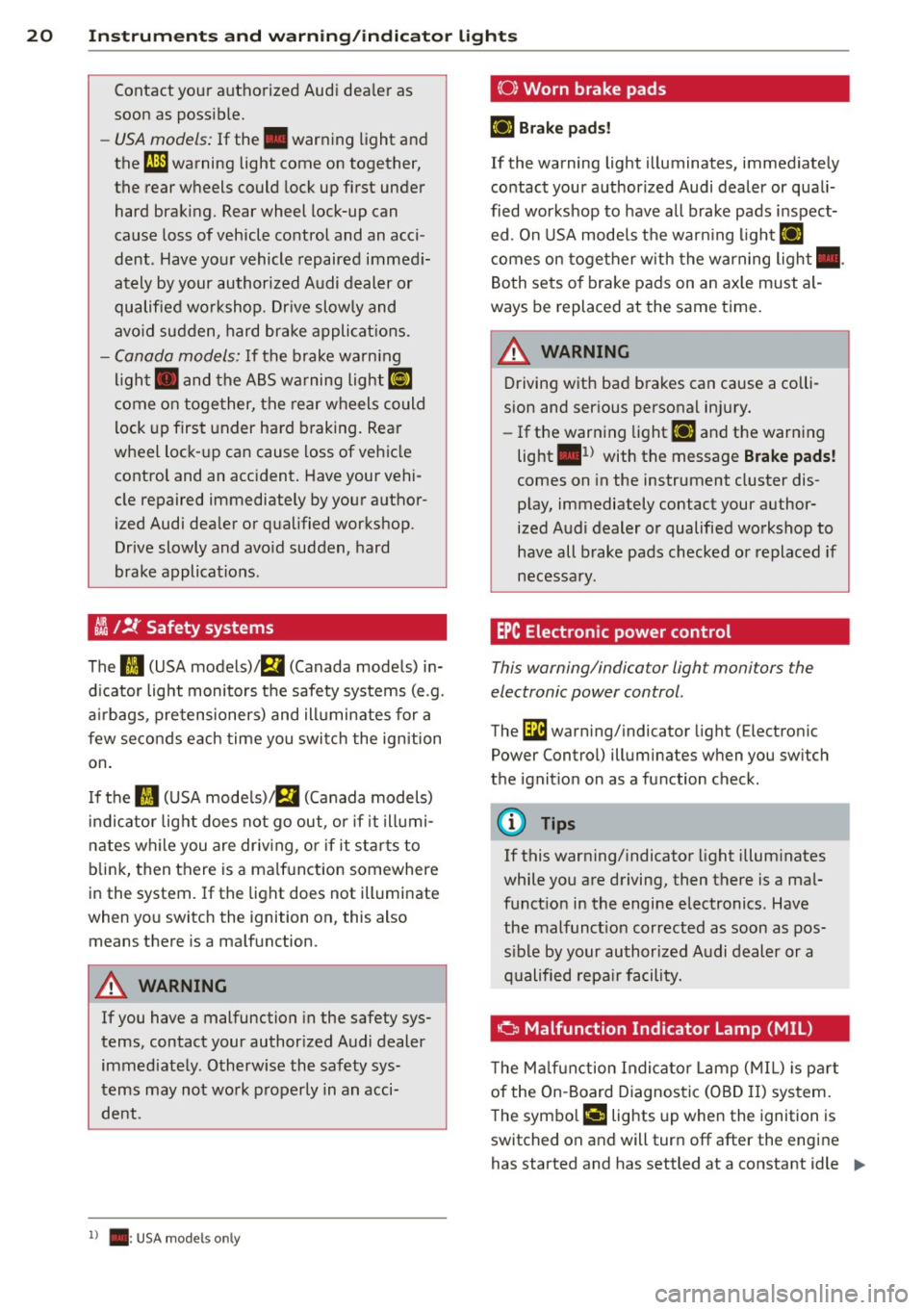
20 Instrum ent s a nd w arn in g/i ndic ato r light s
Contact your authorized Audi dealer as
soon as possible.
- USA models: If the . warning light and
the
rJl1 warning light come on together,
the rear wheels could lock up first under
hard braking. Rear wheel lock-up can
cause loss of vehicle control and an acci
dent . Have your vehicle repaired immed i
ately by your authorized Audi dealer or
qualified workshop. Dr ive slowly and
avo id sudden, hard brake applicat ions.
- Canada models: If the brake warn ing
light . and the ABS warning light
[IJ
come on together, the rear wheels could
lock up first under hard braking. Rear
wheel lock-up can cause loss of vehicle
control and an acc ident. Have your vehi
cle repaired immediately by your author
ized Audi dealer or qualified workshop.
Drive slowly and avoid sudden, hard
brake applicat ions.
~ /!J.' Safety systems
The fl (USA models)/ E,I (Canada models) in
d icator light monitors the safety systems (e .g.
a ir bags, pretensioners) and ill uminates for a
few seconds each time you switch the ignition
on.
I f the
fl (USA mode ls)/ E,I (Canada models)
i ndi cato r light does not go out, or if it illumi
nates wh ile you are driv ing, or if it sta rts to
blink, then there is a ma lfunction somewhere
in the system.
If the light does not illuminate
when you switch the ignition on, this also means there is a malfunction.
A WARNING
If you have a malfunction in the safety sys
tems, contact your author ized Audi dealer
immediately. Otherw ise the safety sys
tems may not work properly in an acci
dent.
l) .: USA mode ls on ly
(0) Worn brake pads
llJ Br ake pad s!
If the warning light illuminates, immed iately
contact your authorized Audi dealer or quali
fied workshop to have all brake pads inspect ed . On USA models the warn ing light
llJ
comes on together with the warning light •.
Both sets of brake pads on an axle must al
ways be replaced at the same time.
A WARNING
Driving with bad brakes can cause a colli
sion and serious personal injury.
- If the warning light
llJ and the warning
light
. 1) with the message Brake pads!
comes on in the instrument cluster dis
play, immediately contact your author
ized Audi dealer or qualified workshop to
have all brake pads checked or replaced if
necessary.
EPC Electronic power control
This warning/indicator light monitors the
electronic power control.
The l3i warn ing/ indicator light (Electron ic
Power Control) illuminates when you sw itch
the ignit ion on as a function check.
(D Tips
If this warning/ indicator light illum inates
while you are driving, then there is a mal
funct ion in the engine electronics. Have
the malfunct ion corrected as soon as pos
s ible by your authorized Audi dealer or a
qualified repa ir facility.
Ci Malfunction Indicator Lamp (MIL)
T he Ma lfun ction Indicator Lamp (MIL) is par t
of the On-Board Diagnostic (OBD II) system.
-
The symbo l ('4 lights up when the ignition is
switched on and will turn off after the engine
has started and has settled at a constant idle
IJ>,
Page 65 of 296
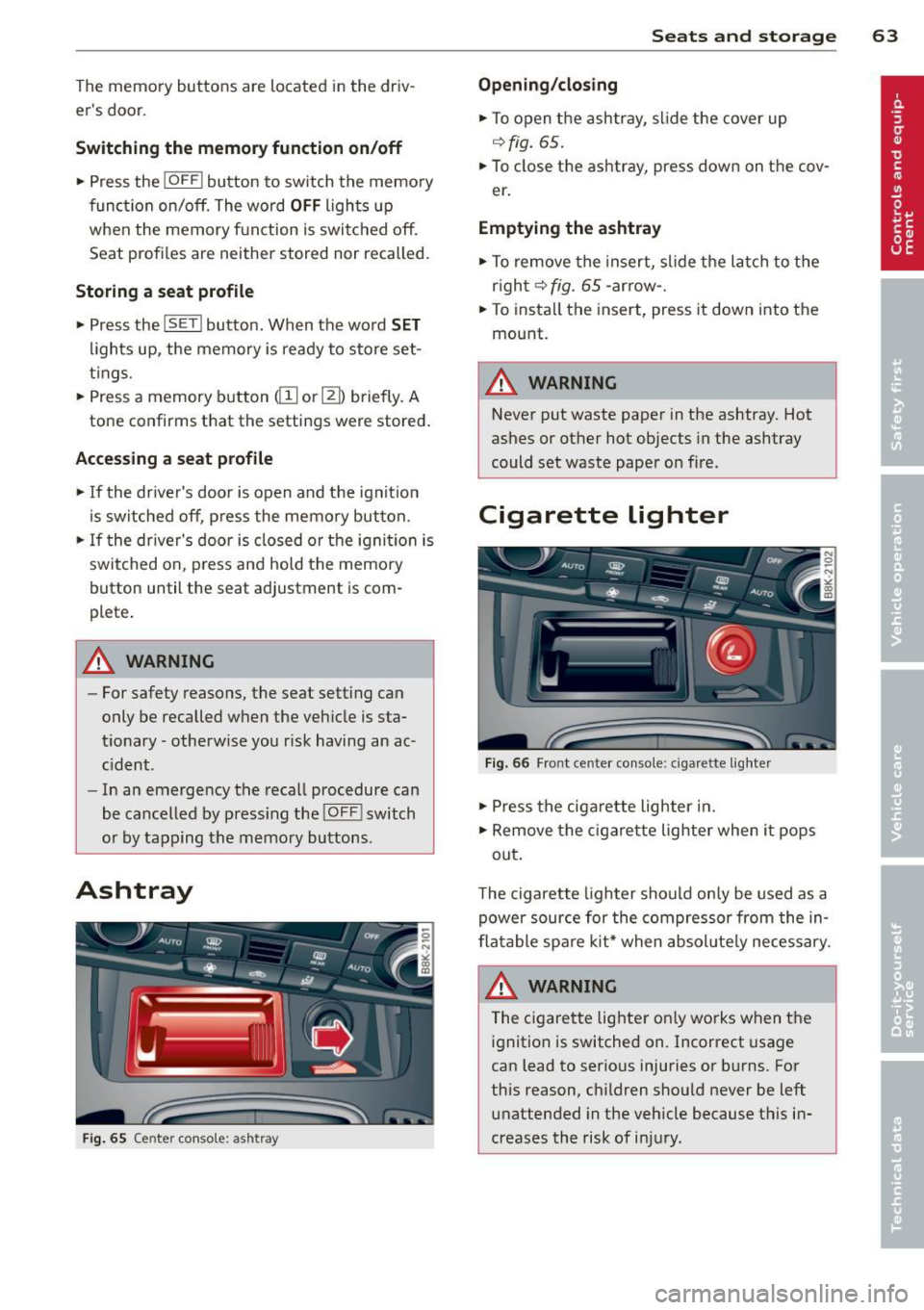
The memory buttons are located in the driv
er's door.
Switching the memory function on/off
• Press the !OFF ! button to switch the memory
function on/off. The word
OFF lights up
when the memory function is switched off.
Seat profiles are neither stored nor recalled.
Storing a seat profile
• Press the !SET ! button. When the word SET
lights up, the memory is ready to store set
t in gs.
• Press a memory button
([II or rn) briefly. A
tone confirms that the settings were stored.
Accessing a seat profile
• If the driver's door is open and the ignition
is switched off, press the memory button.
• If the driver's door is closed or the ignition is
switched on, press and hold the memory
button until the seat adjustment is com
plete .
A WARNING
-For safety reasons, the seat sett ing can
only be recalled when the vehicle is sta
tionary - otherwise you risk having an ac
c ident.
- In an emergency the recall procedure can
be cancelled by press ing the
!OF F! switch
or by tapping the memory buttons.
Ashtray
Fig . 65 Center console: ashtray
Seats and storage 63
Opening/closing
• To open the ashtray, slide the cover up
~fig. 65.
• To close the ashtray, press down on the cov
er .
Emptying the ashtray
• To remove the insert, slide the latch to the
right~
fig. 65 -arrow-.
• To instal l the insert, press it down into the
mount.
A WARNING
Never put waste paper in the ashtray. Hot
ashes or other hot objects in the ashtray
could set waste paper on fire.
Cigarette lighter
Fig. 66 Front center console: cigar ette lighter
• Press the cigarette lighter in.
• Remove the cigarette lighter when it pops
out .
T he cigarette lighter should only be used as a
power source for the compressor from the in
flatable spare kit* when absol ute ly necessary.
A WARNING
The cigarette lighter on ly works when the
ignition is switched on. Incorrect usage
can lead to serious injuries or burns. For
this reason, children should never be left unattended in the vehicle because this in
creases the risk of injury.
Page 89 of 296
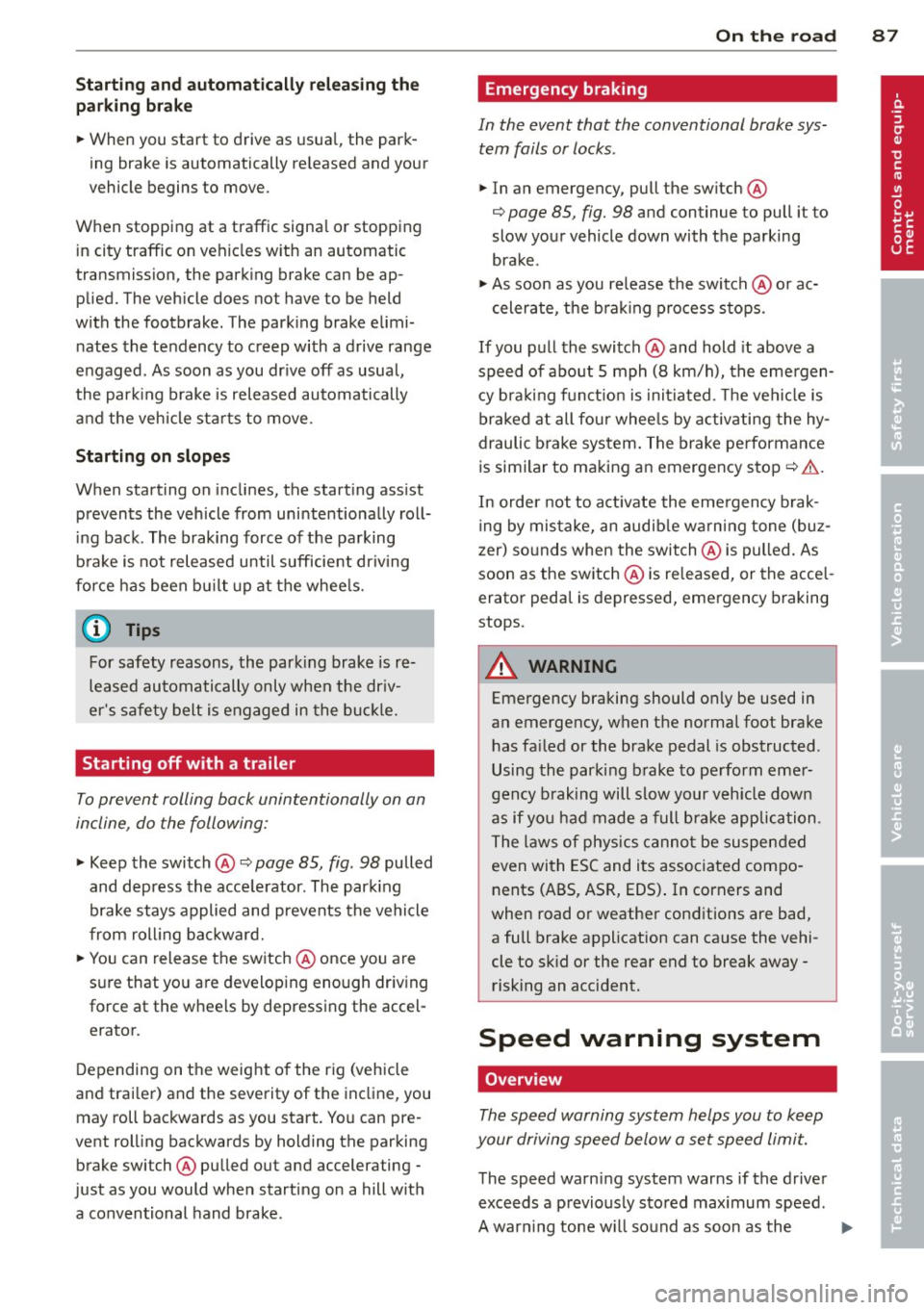
Starting and autom ati call y relea sing the
pa rking b rake
~ When you start to drive as usua l, the park
ing brake is automatically re leased and your
vehicle begins to move.
When stopping at a traffic signa l or stopp ing
in city traffic on vehicles with an automatic
transmission, the parking brake can be ap
plied. The vehicle does not have to be held
w ith the footbrake . The park ing brake elimi
nates the tendency to creep with a drive range
engaged. As soon as you dr ive off as usual,
the park ing brake is released automatically
and the vehicle sta rts to move .
Starting on slop es
When starting on inclines, the start ing ass ist
prevents the vehicle from unintentionally roll
ing back. The braking force of the parking
brake is not released until sufficient dr iving
force has been b uilt up at the whee ls.
(D Tips
For safety reasons, the park ing brake is re
leased automatically only when the dr iv
er 's safety belt is engaged in the buc kle.
Starting off with a trailer
To prevent rolling back unintentionally on an
incline, do the following:
~ Keep the switch@c::> page 85, fig . 98 pulled
and depress the accelerator. The park ing
brake stays applied and prevents the vehicle
from roll ing backward.
~ You can release the switch @once you are
sure that yo u are developing enough driving
force at the wheels by depressing the accel
erator.
D epending on the weight of the rig (vehicle
and trai ler) and the severity of the incline , you
may roll backwards as you start. Yo u can pre
vent roll ing backwards by holding the parking
brake switch @pulled out and accelerating -
just as you would when starting on a hill wit h
a conventional hand brake .
On the ro ad 87
Emergency braking
In the event that the conventional brake sys
tem fails or locks .
~ In an emergency, pull the switch @
c::>
page 85, fig. 98 and continue to pull it to
slow your vehicle down with the parking
brake .
~ As soon as you re lease the switch @or ac-
celerate, the b rak ing process s tops.
If you pull the switch @and hold it above a
speed of about 5 mph (8 km/h), the eme rgen
cy bra king funct ion is initia ted . T he veh icle is
braked at all four whee ls by activating the hy
draulic brake system. The brake performance
is similar to making an emergency stop c::>
&..
In order not to act ivate the eme rgency brak
ing by mis take, an audib le warning tone (buz
zer) so unds when the switch @is pulled. As
soon as the switch @ is re leased, or the acce l
erato r pedal is depressed, emergency braking
stops.
A WARNING
...--
Emergency braking should only be used in
an emergency, when the normal foot brake
has fa iled or the brake pedal is obstructed .
Using the parking b rake to pe rform emer
gency brak ing will slow your vehicle down
as if you had made a full bra ke application .
The laws of physics cannot be suspended
even with ESC and its associated compo
nents (ABS, ASR, EDS) . In corners and
when road or weather conditions are bad,
a full brake application can ca use the vehi
cle to sk id or the rear end to break away -
risking an accident.
Speed warning system
Overview
The speed warning system helps you to keep
your driving speed below a set speed limit.
The speed warn ing system warns if the driver
exceeds a p reviously stored max imum speed .
A warn ing tone w ill sound as soon as the
Ill>
Page 126 of 296
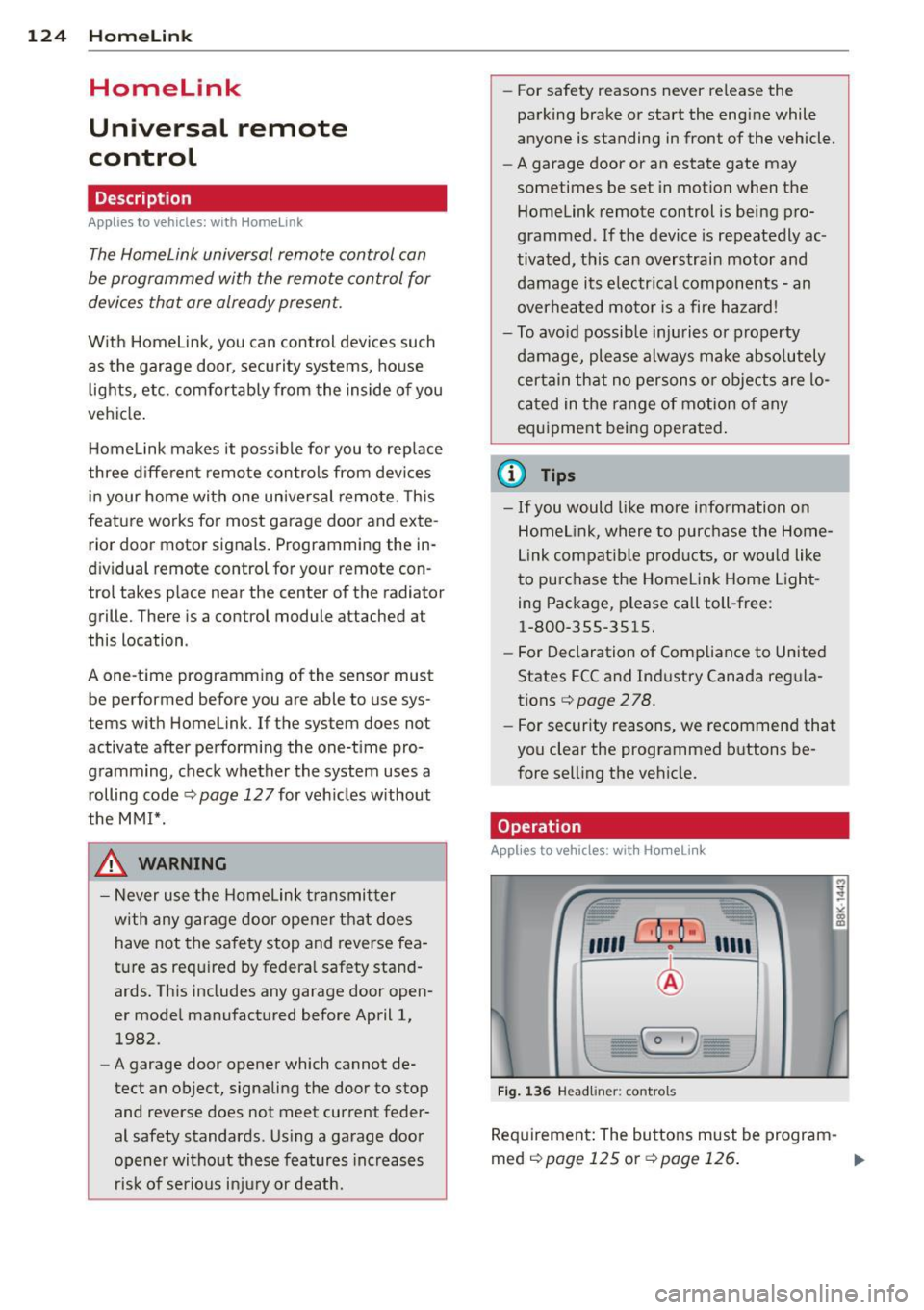
124 Homelin k
Homelink
Universal remote
control
Description
Appl ies to vehicles: wit h Homeli nk
The HomeLink universal remote control can
be programmed with the remote control for
devices that are already present.
W ith Home Link, you can control devices such
as the garage door, security systems, house lights, etc. comfortably from the inside of you
vehicle.
Homelink makes it possible for you to replace
three d ifferent remote controls from dev ices
in your home with one universal remote. This
feature works for most garage door and exte
rior door motor signals. Programming the in
div idual remote control for your remote con
trol takes place near the center of the radiator
grille. There is a control module attached at
this location .
A one -time programm ing of the sensor must
be performed before you are able to use sys
tems with Home link. If the system does not
activate after performing the one-time pro
gramm ing, check whether the system uses a
rolling code
q page 127 for vehicles without
the MMI*.
& WARNING
-
- Never use the Homelink transmitter
with any garage door opener that does
have not the safety stop and reverse fea
ture as required by federa l safety stand
ards. This includes any garage door open
er model manufactured before April 1,
1982.
- A garage door opener which cannot de
tect an object, signaling the door to stop
and reverse does not meet current feder
al safety standards. Using a garage door
opener without these features increases
risk of serious injury or death. -
For safety reasons never release the
parking brake or start the engine while
anyone is standing in front of the vehicle.
- A garage door or an estate gate may
sometimes be set in motion when the
Homelink remote control is being pro
grammed. If the device is repeatedly ac
tivated, this can overstrain motor and
damage its e lectrica l components - an
overheated mo tor is a fire hazard!
- To avo id possib le injuries or property
damage, please always make abso lutely
certain that no persons or objects are lo
cated in the range of motion of any
equipment being operated.
{D Tips
- If you would li ke more information on
Homel ink, where to purchase the Home
Link compat ible prod ucts, or wou ld like
to purchase the Homelink Home Light
ing Package, please call toll-free:
1-800-355-3515.
- For Declaration of Compliance to United
States FCC and Industry Canada regula
tions
¢ page 2 78.
- For security reasons, we recommend that
you clear the programmed buttons be
fore selling the vehicle.
Operation
Applies to veh icles : w it h Ho meli nk
~ ,.......,,...--, ........... ~
,;,,, r . o : o . ) .~
®
Fig. 136 Headl iner: controls
Requirement : The buttons must be program-
med
¢ page 125 or ¢page 126. II>
Page 136 of 296
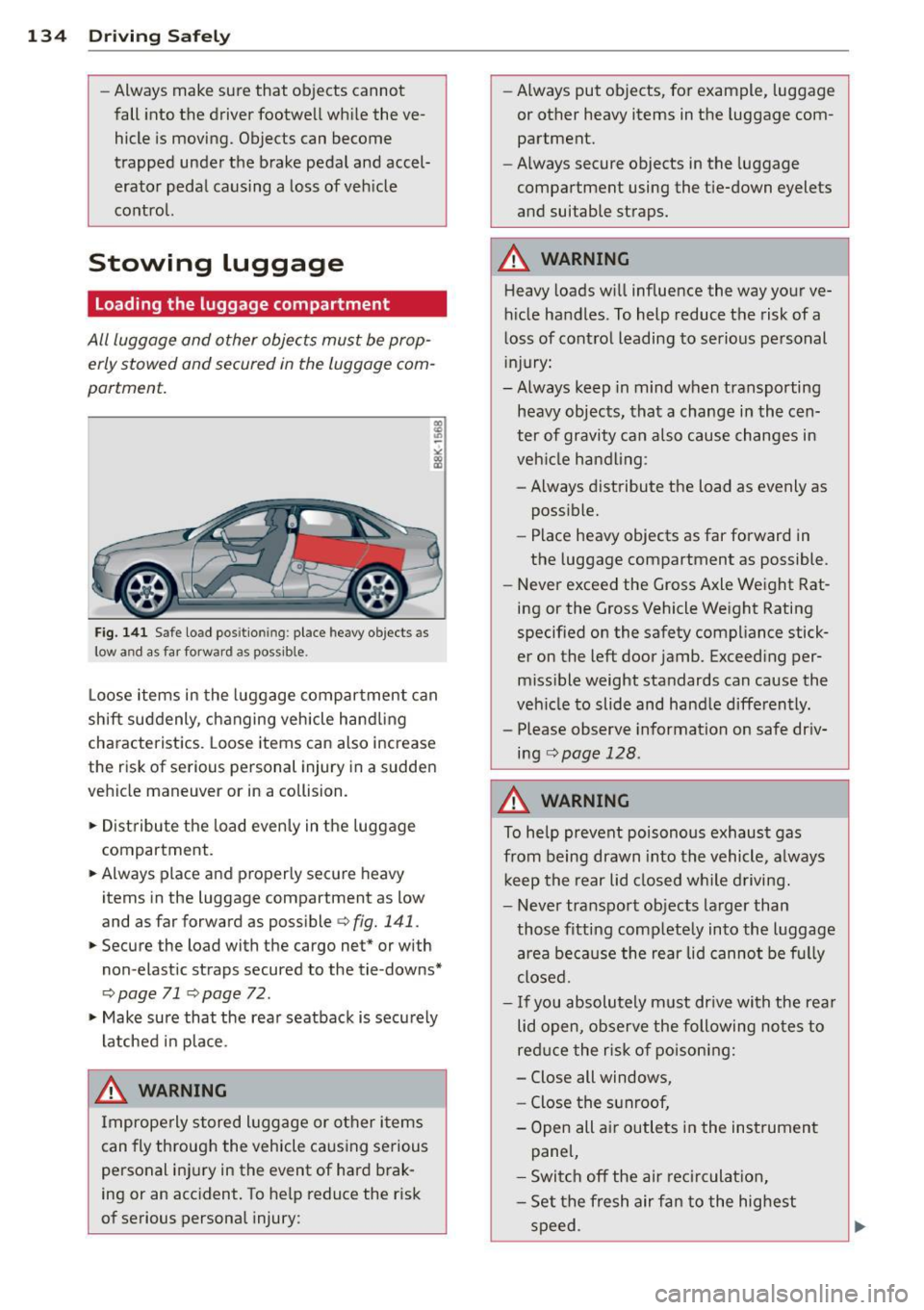
134 Driving Safel y
-Always make sure that objects cannot
fall into the driver footwe ll wh ile the ve
hicle is moving. Objects can become
trapped under the brake pedal and accel
erator peda l causing a loss of veh icle
contro l.
Stowing luggage
Loading the luggage compartment
All luggage and other objects must be prop
erly stowed and secur ed in the luggage com
partment.
Fig. 141 S afe load positio nin g: place heavy objects as
l ow a nd a s far forward as pos sible.
Loose items in the luggage compartment can
shift suddenly, changing vehicle hand ling
characteristics. Loose items can also increase
the risk of serious personal injury in a sudden
vehicle maneuver or in a collision .
.,. Distribute the load even ly in the luggage
compartment .
.,. Always place and properly secure heavy
items in the luggage compartment as low
and as far forward as possible¢
fig. 141.
.,. Secure the load with the cargo net* or with
non -elastic straps secured to the tie-downs*
¢ page 71 ¢page 72 .
.,. Make sure that the rea r seatback is secu rely
latched in place.
.&_ WARNING
Improperly stored luggage or other items
can fly throug h the vehicle ca using serious
personal inj ury in the event of hard brak
ing or an accident. To help reduce the r isk
of serious personal injury: -
Always put objects, for example, luggage
or other heavy items in the luggage com
partment.
- Always secure objects in the luggage
compartment using the t ie-down eyelets
and suitable straps.
.&_ WARNING
-
Heavy loads w ill influence the way your ve
hicle handles . To help reduce the risk of a
loss of control leading to serious personal
in jury:
- Always keep in mind when transporting
heavy objects, that a change in the cen
ter of gravity can also cause changes in
veh icle handling :
- Always distribute the load as evenly as
possible.
- Place heavy objects as far forward in
the luggage compartment as possible .
- Never exceed the Gross Axle Weight Rat
ing or the Gross Vehicle Weight Rating
specified on the safety compliance stick
er on the left door jamb. Exceeding per
missible weight standards can cause the
veh icle to slide and handle differently.
- Please observe information on safe dr iv
ing
c> page 128.
.&_ WARNING
To help prevent poisonous exhaust gas
from being drawn into the vehicle, always
keep the rear lid closed while driving.
- Never transport objects larger than
those fitting completely into the luggage
a rea because the rear lid cannot be fully
closed.
- If you absolutely m ust dr ive with the rear
lid open, observe the following notes to
red uce the risk of poisoning:
- Close all windows,
- Close the sunroof,
- Open all air outlets in the instrument
panel,
- Switc h off the ai r recirculation,
- Set the fresh air fan to the highest
speed.
Page 141 of 296
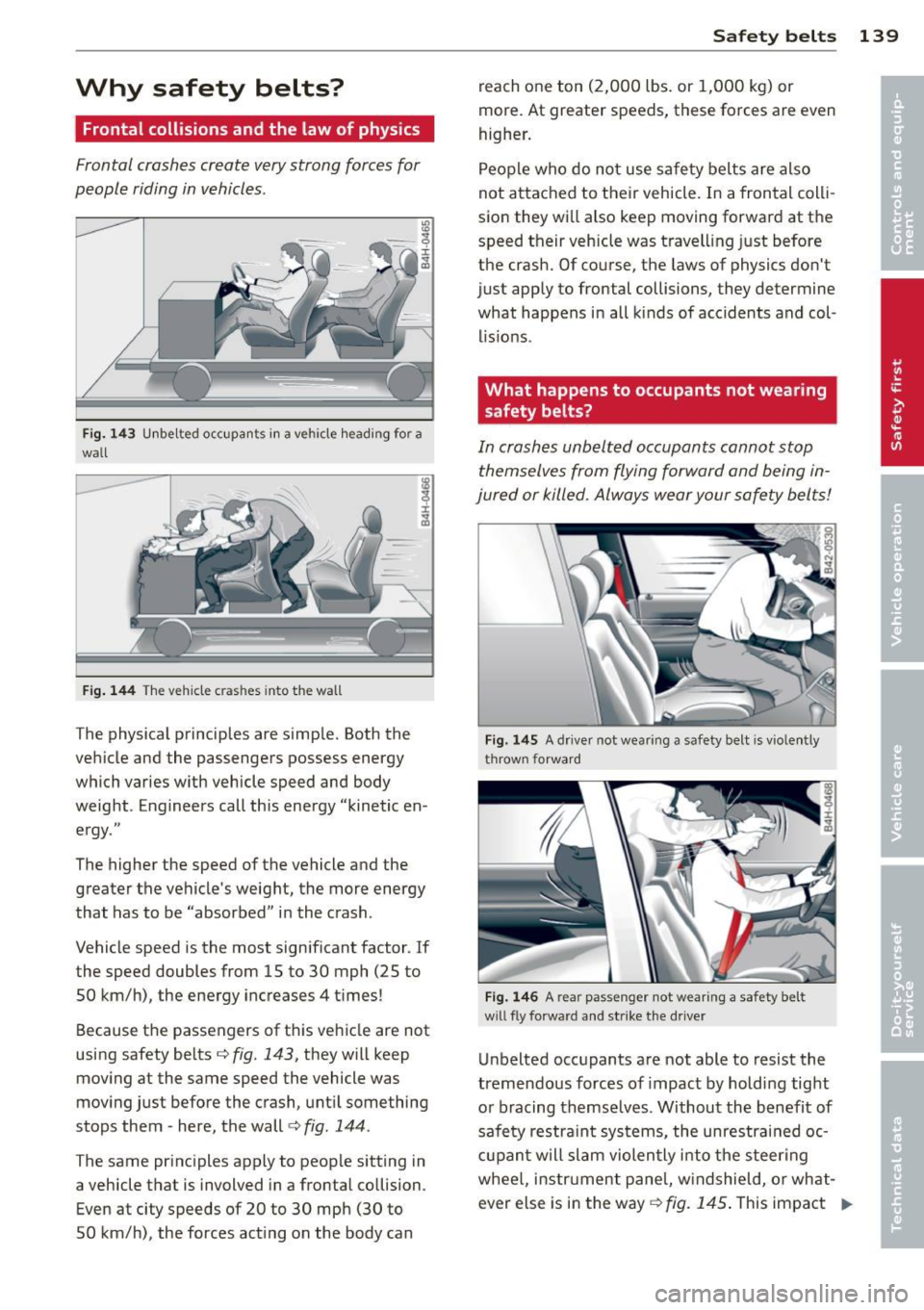
Why safety belts?
Frontal collisions and the law of physics
Frontal crashes create very strong forces for
people riding in vehicles .
Fig. 14 3 Unbe lted occupa nts in a ve hicle hea ding for a
wall
F ig. 14 4 The ve hicle c ras hes into t he wall
The physical principles are simp le. Both the
ve hicle and the passengers possess energy
which varies w ith vehicle speed and body
weight . Enginee rs call this energy "kinetic en
e rgy ."
The higher the speed of the vehicle and the greater the vehicle 's weight, the more energy
that has to be "absorbed" i n the crash .
Vehicle speed is the most sign ificant factor . If
the speed doubles from 15 to 30 mph (25 to
50 km/h) , the energy inc reases 4 t imes !
Because t he passengers of t his ve hicle are not
using safety belts
r::;, fig . 143, they w ill keep
moving at the same speed the vehicle was
mov ing just before the crash, unt il something
stops them -here, the wall
c:> fig . 144.
The same pr inc iples apply to peop le sitting in
a vehicle that is involved in a frontal co llision .
Even at city speeds of 20 to 30 mph (30 to
50 km/h) , the forces act ing on the body can Safety belts
139
reach one ton (2,000 lbs . or 1,000 kg) or
more . At greater speeds, these forces are
even
higher .
People who do not use sa fe ty belts are also
not attached to their vehicle. In a frontal coll i
sio n they wi ll also keep moving forward at the
speed their veh icle was t ravell ing just before
the crash. Of co urse, the laws of physics don't
just app ly to frontal collisions, they determine
what happens in all kinds of acc idents and col
lis ions .
What happens to occupants not wearing
safety belts?
In crashes unbelt ed o ccupants cannot stop
themselves from flying forward and being in
jured or killed. Always wear your safety belts!
Fig. 145 A driver not wear ing a safety belt is vi ole ntl y
thrown forwa rd
Fig.
14 6 A rear passeng er not w ear ing a safety be lt
w ill fly forwar d and s trike the d river
Unbelted occ upants a re not able to resist the
tremendous forces of impact by hold ing tight
or bracing themselves . Without the benefit of
safe ty restra in t systems, the unrestrained oc
cupan t w ill slam violen tly i nto the s teer ing
whee l, instr ument pane l, w indshield, o r what
ever else is in the way ¢ fig. 145. This impact Ill-